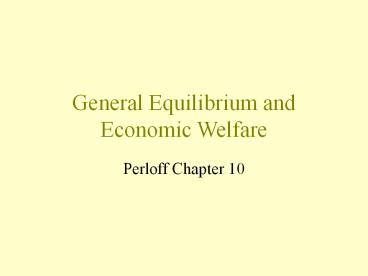General Equilibrium and Economic Welfare
Title:
General Equilibrium and Economic Welfare
Description:
General Equilibrium and Economic Welfare Perloff Chapter 10 General Equilibrium Partial equilibrium Changes in equilibrium are analysed in one (or a few) markets in ... –
Number of Views:194
Avg rating:3.0/5.0
Title: General Equilibrium and Economic Welfare
1
General Equilibrium and Economic Welfare
- Perloff Chapter 10
2
General Equilibrium
- Partial equilibrium
- Changes in equilibrium are analysed in one (or a
few) markets in isolation. - Prices and quantities in unrelated markets are
held fixed. - General equilibrium
- The study of how equilibrium is attained in all
markets simultaneously.
3
GE in Corn and Soya Beans
(a) Corn Market
c
S
0
c
S
3
c
e
0
2.15
Price, per bushel
c
D
0
c
e
c
1
e
1.9171
3
1.9057
c
D
1
8.44
8.2613
8.227
Corn, Billion bushels per year
(b) Soybean Market
s
S
0
s
e
0
4.
12
Price, per bushel
s
D
0
s
S
2
s
S
4
s
e
2
3.8325
3.8180
s
e
4
s
D
2
s
D
4
2.07
2.0514
2.0505
Soybeans, Billion bushels per year
4
Min. wages with incomplete coverage
(a) Covered Sector
(b) Uncovered Sector
(c) Total Labor Market
w, Wage per hour
w, Wage per hour
w, Wage per hour
S
w
u
S
w
w
w
1
1
1
w
2
c
u
D
D
D
2
1
2
1
1
1
L
L
L
L
L
L
L
c
c
u
u
c
u
1
L
, Annual hours
L
, Annual hours
L
, Annual hours
c
u
5
Trade Between People The Edgeworth Box
(a) Jane
s Endowment
(b) Denise
s Endowment
e
Firewood, Cords
Firewood, Cords
j
30
e
d
20
1
I
d
1
I
j
0
0
20
60
j
d
Jane
s candy
Denise
s candy
Candy, Bars
Candy, Bars
6
Obtaining the contract curve
Denise
s candy
60
80
40
0
d
50
g
Denises wood
0
Contract curve
I
d
d
4
I
1
I
e
j
d
30
20
2
I
d
c
3
I
f
d
20
30
B
3
I
j
b
2
I
j
1
I
j
Janes wood
a
50
0
20
40
80
j
Jane
s candy
7
Four equivalent statements about points on the
contract curve
- The indifference curves are tangential.
- The marginal rates of substitution are equal.
- No further mutually beneficial trades are
possible. - The allocation is Pareto efficient One person
cannot be made better off without making the
other worse off.
8
Price that doesnt lead to equilibrium
(b) Prices That Do Not Lead to a Competitive
Equilibrium
Denise
s candy
60
80
43
0
d
50
45
Denises wood
1
I
e
d
30
20
2
I
d
j
22
d
32
2
I
j
1
I
j
Janes wood
Price line
a
50
0
80
20
30
60
j
Jane
s candy
9
Price that leads to equilibrium
(a) Price Line That Leads to a Competitive
Equilibrium
Denise
s candy
60
80
40
0
d
50
Denises wood
40
1
I
e
d
20
30
2
I
d
f
20
30
2
I
j
1
I
j
Janes wood
Price line
a
50
0
20
40
80
j
Jane
s candy
10
Theorems of Welfare Economics
- The competitive equilibrium is Pareto efficient.
- Any efficient allocations can be achieved by
competition. - Any point on the contract curve can be achieved
by trade along the appropriate price line. - Achieving the desired point may involve some
redistribution (value judgements required)
11
Production Possibilities
2
I
Firewood, Cords
1
I
PPF
a
50
b
80
Candy, Bars
12
Competition Ensures Efficiency
13
The whole picture
Price line
1
Firewood, Cords
2
1
PPF
a
50
0
80
Candy, Bars
j
14
Is efficiency enough?
- Many policies make somebody better off at the
expense of somebody else. - Producer surplus plus consumer surplus.
- As long as producers gain more than consumers
lose, its efficient eg. first degree price
discrimination. - Weights producers and consumers equally.
15
Utility possibilities frontier
Denise
s candy
0
d
Denises utility
UPF
Denises wood
Janes wood
0
j
Jane
s candy
Jane
s utility
16
Welfare maximisation
(a)
(b)
a
Denises utility
Denises utility
UPF
UPF
e
b
3
W
2
W
1
W
1
2
3
W
W
W
c
Jane
s utility
Jane
s utility
17
How do we arrive at a social preference ranking
- Individuals rankings are transitive
- We need a rule which allows us to convert
individual rankings into a social ranking. - Majority voting
- 2 prefer a to b, 2 prefer b to c, transitivity
would require 2 to prefer a to c. - But 2 prefer c to a.
18
Voting with non-transitive prefrences
- With non-transitive preferences result depends on
order the vote is taken in. - a compared to b then compare winner to c
- a chosen in first vote
- c chosen in second vote
- c compared to a then compare winner to b
- c chosen in first vote
- b chosen in second vote
19
Arrows impossibility theorem
- Desirable properties of a social preference
ordering. - Complete
- If everyone prefers a to b, the social ranking
should do the same - Social ranking of a to b should not depend on the
what other alternatives are available - Dictatorship is not allowed
- No rule exists which produces a ranking that
always satisfies these properties































